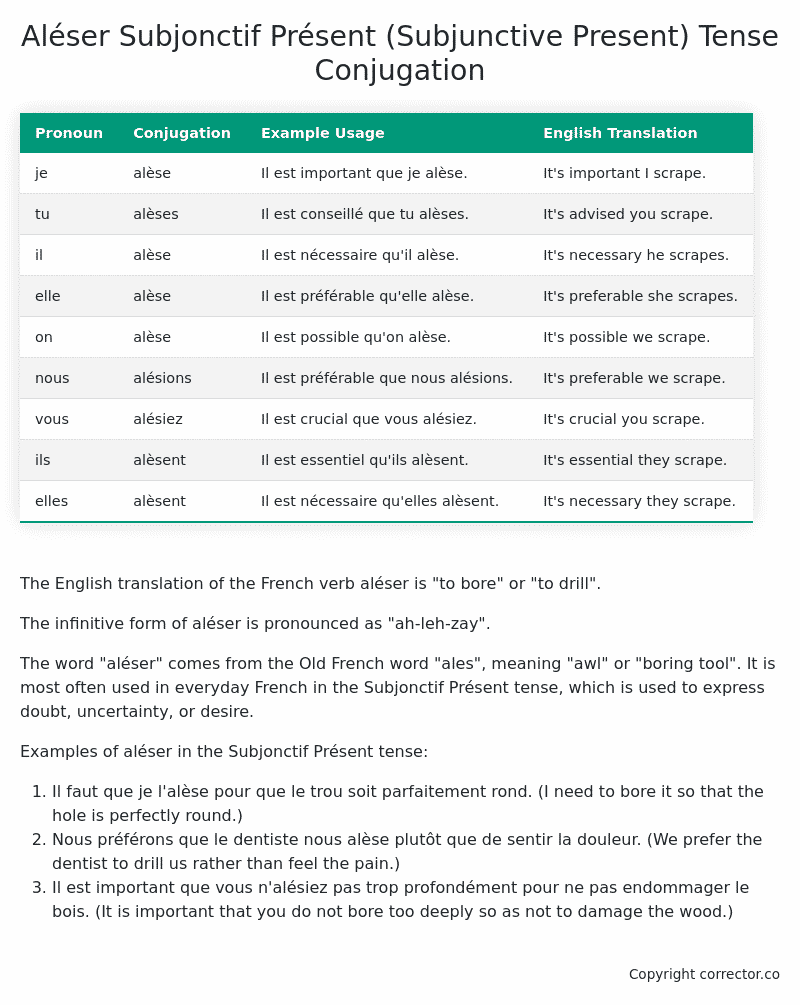Subjonctif Présent (Subjunctive Present) Tense Conjugation of the French Verb aléser
Introduction to the verb aléser
The English translation of the French verb aléser is “to bore” or “to drill”.
The infinitive form of aléser is pronounced as “ah-leh-zay”.
The word “aléser” comes from the Old French word “ales”, meaning “awl” or “boring tool”. It is most often used in everyday French in the Subjonctif Présent tense, which is used to express doubt, uncertainty, or desire.
Examples of aléser in the Subjonctif Présent tense:
- Il faut que je l’alèse pour que le trou soit parfaitement rond. (I need to bore it so that the hole is perfectly round.)
- Nous préférons que le dentiste nous alèse plutôt que de sentir la douleur. (We prefer the dentist to drill us rather than feel the pain.)
- Il est important que vous n’alésiez pas trop profondément pour ne pas endommager le bois. (It is important that you do not bore too deeply so as not to damage the wood.)
Table of the Subjonctif Présent (Subjunctive Present) Tense Conjugation of aléser
| Pronoun | Conjugation | Example Usage | English Translation |
|---|---|---|---|
| je | alèse | Il est important que je alèse. | It’s important I scrape. |
| tu | alèses | Il est conseillé que tu alèses. | It’s advised you scrape. |
| il | alèse | Il est nécessaire qu’il alèse. | It’s necessary he scrapes. |
| elle | alèse | Il est préférable qu’elle alèse. | It’s preferable she scrapes. |
| on | alèse | Il est possible qu’on alèse. | It’s possible we scrape. |
| nous | alésions | Il est préférable que nous alésions. | It’s preferable we scrape. |
| vous | alésiez | Il est crucial que vous alésiez. | It’s crucial you scrape. |
| ils | alèsent | Il est essentiel qu’ils alèsent. | It’s essential they scrape. |
| elles | alèsent | Il est nécessaire qu’elles alèsent. | It’s necessary they scrape. |
Other Conjugations for Aléser.
Le Present (Present Tense) Conjugation of the French Verb aléser
Imparfait (Imperfect) Tense Conjugation of the French Verb aléser
Passé Simple (Simple Past) Tense Conjugation of the French Verb aléser
Passé Composé (Present Perfect) Tense Conjugation of the French Verb aléser
Futur Simple (Simple Future) Tense Conjugation of the French Verb aléser
Futur Proche (Near Future) Tense Conjugation of the French Verb aléser
Plus-que-parfait (Pluperfect) Tense Conjugation of the French Verb aléser
Passé Antérieur (Past Anterior) Tense Conjugation of the French Verb aléser
Futur Antérieur (Future Anterior) Tense Conjugation of the French Verb aléser
Subjonctif Présent (Subjunctive Present) Tense Conjugation of the French Verb aléser (this article)
Subjonctif Passé (Subjunctive Past) Tense Conjugation of the French Verb aléser
Subjonctif Imparfait (Subjunctive Imperfect) Tense Conjugation of the French Verb aléser
Subjonctif Plus-que-parfait (Subjunctive Pluperfect) Tense Conjugation of the French Verb aléser
Conditionnel Présent (Conditional Present) Tense Conjugation of the French Verb aléser
Conditionnel Passé (Conditional Past) Tense Conjugation of the French Verb aléser
L’impératif Présent (Imperative Present) Tense Conjugation of the French Verb aléser
L’infinitif Présent (Infinitive Present) Tense Conjugation of the French Verb aléser
Struggling with French verbs or the language in general? Why not use our free French Grammar Checker – no registration required!
Get a FREE Download Study Sheet of this Conjugation 🔥
Simply right click the image below, click “save image” and get your free reference for the aléser Subjonctif Présent tense conjugation!

Aléser – About the French Subjonctif Présent (Subjunctive Present) Tense
Formation of the Subjonctif Présent
Common Everyday Usage Patterns
Interactions with Other Tenses
Summary
I hope you enjoyed this article on the verb aléser. Still in a learning mood? Check out another TOTALLY random French verb conjugation!


